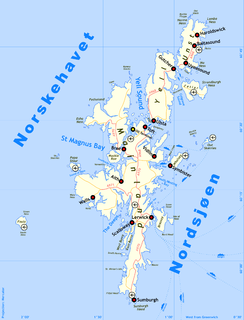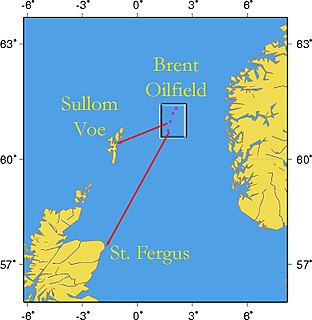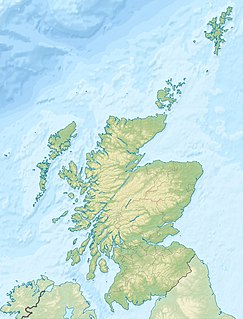Related Research Articles

Iolair is a specialised semi-submersible offshore platform designed for BP to support and service oil platforms in the North Sea and served as an emergency support vessel (ESV) in the Forties Oil Field. Since 2000 it has been working in the Cantarell Field, Mexico as an offshore construction and maintenance service vessel operated by Cotemar S.A de C.V.

Sullom Voe is an inlet between North Mainland and Northmavine in Shetland, Scotland. It is a location of the Sullom Voe oil terminal and Shetland Gas Plant. The word Voe is from the Old Norse vagr and denotes a small bay or narrow creek.

The Brent field is an oil and gas field located in the East Shetland Basin of the North Sea, 186 kilometres (116 mi) north-east of Lerwick, Shetland Islands, Scotland, at the water depth of 140 metres (460 ft). The field operated by Shell UK Limited was once one of the most productive parts of the UK's offshore assets but has reached the stage where production is no longer economically viable. Decommissioning of the Brent field is ongoing and will be completed in the early 2020s.
The East Shetland Basin is a major oil-producing area of the North Sea between Scotland and Norway.
The FLAGS pipeline is a natural gas pipeline in the North Sea which is used to transport liquids and associated gas from the following fields:

The Clair oilfield is an offshore oil field in Scottish territorial waters 75 kilometres (47 mi) west of Shetland in water depths of up to 140 metres (460 ft). It extends over an area of some 220 square kilometres (85 sq mi), covering five licence blocks.

Scatsta Airport, is a commercial airport on the island of Mainland, Shetland in Scotland located 17 nautical miles north of Lerwick and 5 mi (8.0 km) southwest of Sullom Voe Terminal.

The Everest gasfield is located in the Central North Sea, 233 kilometres (145 mi) east of Aberdeen, Scotland. It lies in the United Kingdom Continental Shelf blocks 22/9, 22/10a and 22/14a. The gasfield was discovered by Amoco in 1982 with first gas produced in 1993. Until 2009, the field was operated by BP. As a result of assets' swap between BP and BG Group in 2009, BG Group became the largest stakeholder of field with 80.46% interest and it took over operatorship of the field. Other partners beside of BG Group are Amerada Hess, and Total. The 1.0134% interest, which was owned by ConocoPhillips, was acquired by BG Group in 2007. On 1 November 2017 Chrysaor announced they had acquired a 100 per cent equity interest in the Everest Field, together with interests in the Beryl, Buzzard, Elgin-Franklin, Erskine, Armada, J Block, Lomond and Schiehallion fields.
This is a list of oil and gas fields operated by BP.

The Schiehallion oilfield is a deepwater offshore oilfield approximately 175 kilometres (110 mi) west of the Shetland Islands in the North Atlantic Ocean. The Schiehallion and adjacent Loyal field were jointly developed by BP on behalf of the Schiehallion field partners; BP, Shell, Amerada Hess, Murphy Oil, Statoil and OMV, and the Loyal field partners; BP and Shell.

Foinaven oil field is deepwater oil development approximately 190 kilometres (120 mi) west of the Shetland Islands. Together with Schiehallion, Loyal, Solan, Clair and Lancaster fields it forms the area generally termed as the West of Shetland.
Sakhalin Energy Investment Company Ltd. is a consortium for developing the Sakhalin-2 oil and gas project with corporate head office in Yuzhno-Sakhalinsk. The chief executive officer is Roman Dashkov.

The Central Area Transmission System is a natural gas transportation and processing system that transports gas through 404 kilometres of pipeline from the Central North Sea to a reception and processing terminal at Teesside in the North East of England.

The Sullom Voe Terminal is an oil and gas terminal at Sullom Voe in the Shetland Islands of Scotland. It handles production from oilfields in the North Sea and East Shetland Basin and stores oil before it is transported by tanker.
The Ninian Pipeline is a 175 kilometres (109 mi) long oil pipeline, which runs from CNR International's Ninian Central platform in North Sea to the Sullom Voe Terminal in Shetland Islands of Scotland. The pipeline carries crude oil from the Ninian Central, Ninian North and Ninian South, Magnus, South Magnus, Heather, Lyell, Columba and Strathspey oil fields. The 36 inches (910 mm) diameter pipeline was laid in 1975-1976. The first oil was received at the Sullom Voe Terminal in December 1978. The pipeline is operated by BP on behalf of the partner companies.

The Magnus oilfield is a large oilfield in the United Kingdom's zone of North Sea. It is located 160 kilometres (99 mi) north-east of the Shetland Islands. The field is located mainly in Block 211/12a. Resources are estimated to total 1.54 billion barrels of oil, of which 869 million barrels are recoverable reserves.

The Shetland Gas Plant is a natural-gas processing plant in the Shetland Islands, Scotland.
The Faroe-Shetland Basin is a sedimentary basin formed by mainly Mesozoic rifting that lies between the Faroe Islands and the Shetland Islands. It has been the site of hydrocarbon exploration since the 1960s, with many significant oil and gas discoveries, including the Clair oilfield, which had an estimated 8 billion barrels of oil in place before production started, the Schiehallion oilfield and the Lancaster oilfield.
The Murchison oil field is located in the northern North Sea in the East Shetland Basin on the UK Continental Shelf. The field is situated 150 km north-east of Shetland and straddles the UK/Norwegian median line. It lies in UK Block 211/19 and extends into Norwegian Block 33/9. The field is named after the Scottish geologist Sir Roderick Impey Murchison (1792–1871). Recoverable reserves were estimated to be 340 million barrels of oil out of a total oil-in-place of 790 million barrels. The field was developed through a large steel jacket platform standing in 156 m of water. The peak production rate was 150,383 barrels of oil per day in December 1982. Oil production was supported by gas and water injection. Production ceased in 2014 and the platform was removed in 2017.
References
- ↑ "West of Shetland Area". UK offshore oil and gas. House of Commons of the United Kingdom, Energy and Climate Change Select Committee. 2009. Retrieved 19 December 2009.
- 1 2 3 "WOSP Background". BP . Retrieved 19 December 2009.
- ↑ "Magnus EOR, Shetlands, United Kingdom". offshore-technology.com. Net Resources International. Retrieved 1 December 2009.